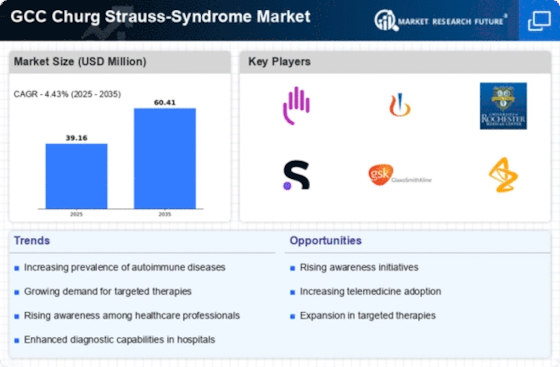Advancements in Diagnostic Technologies
Advancements in diagnostic technologies are significantly impacting the churg strauss-syndrome market. Enhanced imaging techniques and biomarker identification have improved the accuracy and speed of diagnosis, allowing for earlier intervention. In the GCC, the integration of advanced laboratory services and telemedicine is facilitating better access to diagnostic resources. As healthcare providers adopt these technologies, the rate of diagnosis is likely to increase, leading to a higher demand for treatment options. Moreover, the ability to accurately diagnose Churg Strauss syndrome can help in differentiating it from other similar conditions, which is crucial for effective management. This trend suggests that the churg strauss-syndrome market will benefit from the ongoing innovations in diagnostic capabilities, ultimately improving patient outcomes.
Rising Demand for Personalized Medicine
The rising demand for personalized medicine is influencing the churg strauss-syndrome market. Patients and healthcare providers are increasingly seeking tailored treatment approaches that consider individual genetic profiles and disease characteristics. In the GCC, this trend is becoming more pronounced as advancements in genomics and biotechnology pave the way for customized therapies. Personalized medicine may lead to more effective treatment regimens for Churg Strauss syndrome, potentially improving patient outcomes and satisfaction. As the market shifts towards individualized care, pharmaceutical companies are likely to invest in research and development of targeted therapies. This evolution in treatment paradigms suggests that the churg strauss-syndrome market will continue to grow as it aligns with the broader movement towards personalized healthcare.
Increased Collaboration Among Stakeholders
Increased collaboration among stakeholders in the healthcare sector is emerging as a vital driver for the churg strauss-syndrome market. Partnerships between pharmaceutical companies, research institutions, and healthcare providers are fostering innovation and accelerating the development of new therapies. In the GCC, collaborative efforts are being made to enhance awareness and education regarding Churg Strauss syndrome, which may lead to improved diagnosis and treatment options. Furthermore, these collaborations can facilitate clinical trials and research initiatives, ultimately contributing to a more robust understanding of the disease. As stakeholders work together to address the challenges associated with Churg Strauss syndrome, the market is likely to benefit from a more coordinated approach to patient care and treatment development.
Increasing Incidence of Churg Strauss Syndrome
The rising incidence of Churg Strauss syndrome in the GCC region is a notable driver for the churg strauss-syndrome market. Recent studies indicate that the prevalence of this condition is increasing, potentially due to environmental factors and genetic predispositions. As healthcare providers become more aware of the symptoms and diagnostic criteria, the number of diagnosed cases is likely to rise. This increase in incidence may lead to a greater demand for treatment options, thereby expanding the market. Furthermore, the growing population in the GCC, coupled with an aging demographic, could contribute to a higher number of cases, necessitating more comprehensive healthcare solutions. Consequently, the churg strauss-syndrome market is expected to experience growth as healthcare systems adapt to meet the needs of this patient population.
Growing Investment in Healthcare Infrastructure
The growing investment in healthcare infrastructure within the GCC is a critical driver for the churg strauss-syndrome market. Governments in the region are prioritizing healthcare development, leading to the establishment of advanced medical facilities and research institutions. This investment is likely to enhance the availability of specialized care for patients with Churg Strauss syndrome. Additionally, increased funding for research initiatives may lead to the discovery of new treatment modalities and therapies. As healthcare systems evolve, the churg strauss-syndrome market is expected to expand, providing patients with better access to care and innovative treatment options. The focus on improving healthcare infrastructure indicates a commitment to addressing rare diseases, which could further stimulate market growth.

















Leave a Comment